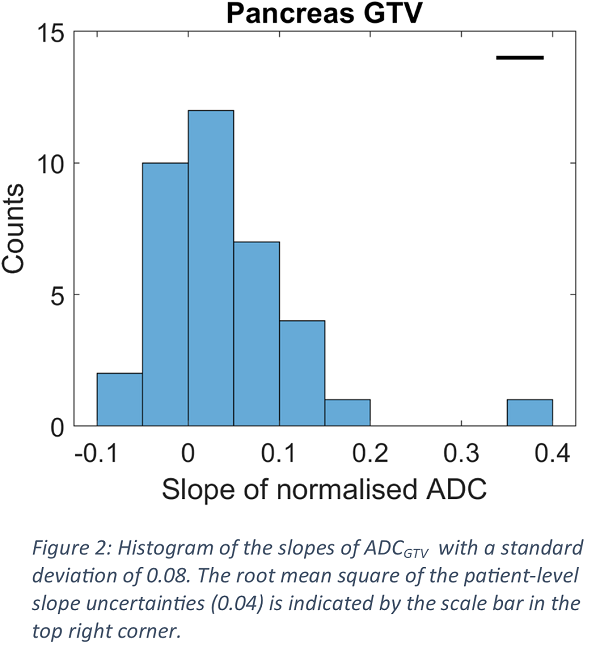Longitudinal ADC measured with MR-linac in patients with pancreatic tumours
PO-2076
Abstract
Longitudinal ADC measured with MR-linac in patients with pancreatic tumours
Authors: Anne Bisgaard1,2, Uffe Bernchou1, Anders S. Bertelsen1, Tine Schytte3,4, Carsten Brink1,4, Mathilde Weisz Ejlsmark3,4, Faisal Mahmood1,4
1Odense University Hospital, Laboratory of Radiation Physics, Department of Oncology, Odense, Denmark; 2University of Southern Denmark, Department of Clinical Research, Odense C, Denmark; 3Odense University Hospital, Department of Oncology, Odense, Denmark; 4University of Southern Denmark, Department of Clinical Research, Odense, Denmark
Show Affiliations
Hide Affiliations
Purpose or Objective
The apparent diffusion coefficient (ADC), derived from diffusion-weighted magnetic resonance imaging (DWI) is a potential radiotherapy (RT) response biomarker. The aim of this study was to investigate if treatment response can potentially be measured during RT using longitudinal ADC measurements in patients with pancreatic tumours.
Material and Methods
The study included 37 patients with pancreatic tumours receiving 50 Gy in five fractions on a 1.5 T MR-linac (Unity, Elekta). DWI scans were acquired at each fraction, and ADC values were calculated both within the gross tumour volume (GTV) (ADC_GTV) and the kidney (ADC_kidney) that was far outside the high dose region. Calculations were based on the median DWI signal at b-values 150 and 500 s/mm2. A visual inspection of the images was performed to check for artifacts in or near the relevant regions. For each patient, ADC values were normalized to the value at the first fraction, and the time dependency was measured as the slope of a linear fit of the normalized ADC as a function of fraction number. For each fit, the one standard deviation regression uncertainty of the measured slope was estimated. The individual slope uncertainties were combined using the root of mean squares (RMS) of the individual patient values. This value was compared to the observed cohort variation.
Results
In mean, the normalized ADC_GTV increased by 14.8 % (SD: 39.3 %) between fraction one and five, while ADC_kidney decreased by 0.8 % (SD: 12.4 %) (Figure 1). The ADC_GTV slopes varied between patients and had a standard deviation of 0.08 (Figure 2). In comparison, the RMS of the individual slopes was smaller (0.04), indicating that the ADC slopes can potentially be used for patient stratification.


Conclusion
Longitudinal ADC of pancreatic tumours has potential to detect relevant patient-specific biological changes during RT. This might be used for response assessment and patient stratification. Further evaluation is needed to determine if changes can be captured early in the treatment course, and to establish correlation to outcome.